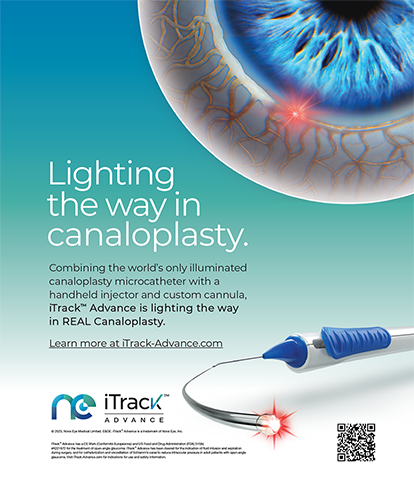A floppy iris presents challenges in addition to those associated with a small pupil, because the iris tends to prolapse and is easily caught in the phacoemulsifier. Traditional pupillary stretching techniques and sphincterotomies are not effective for managing the problem. Preoperatively, it is important to identify patients likely to develop IFIS in order to take the appropriate measures to ensure adequate pupillary dilation throughout surgery.1 Inserting a Perfect Pupil Injectable (PPI; Milvella Ltd, Sydney, Australia) reliably produces a large, round pupil and protects its margin, thereby converting a potentially challenging case into a routine one.
SURGICAL TECHNIQUE
Incision
I make a 3.2-mm, clear corneal incision temporally (or superior/inferior temporally). It easily allows 0.4mm for the arm of the PPI and 2.7mm for the phaco tip, and the incision is large enough to prevent any movement of the PPI by the frictional force of the phaco tip.
Viscosurgical Device
I prefer to use Healon 5 (Advanced Medical Optics, Inc., Santa Ana, CA), which will generally enlarge the pupil to approximately 6mm. I find it most effective to inject the ophthalmic viscosurgical device (OVD) close to the pupillary edge and then to move it around the pupil in a segmental fashion. The enlarged pupil simplifies the PPI's insertion, and no re-injection of the Healon 5 is necessary when I manipulate the PPI into the pupil.
Inserting the PPI
The PPI may be inserted into the anterior chamber with either an injector or a forceps. In eyes with IFIS, it is important to insert the device as gently as possible and to keep it clear of the anterior surface of the iris. It is preferable not to inject the PPI directly into the pupil, as that tends to torque the iris. Instead, the surgeon manipulates the PPI into the pupil with a Sinskey hook or Lester manipulator. I prefer the latter instrument, because it does not catch the iris while I manipulate the device.
My usual method for positioning the PPI in the pupil is as follows: the zone adjacent to the arm first, followed by the tab and then the free end2 (Figure 1). I generally manipulate the device via the keratome incision, but some surgeons may prefer to use a stab incision.
Capsulorhexis
I create the capsulorhexis in my usual fashion. The PPI's placement results in a round, 7.5- to 8.0-mm pupil and minimizes false reference points so that the capsulorhexis is centrally located.
Hydrodissection
It is important that hydrodissection be gentle in order to avoid any stress on the iris. I always perform 360° hydrodissection so that I can easily rotate the lenticular material.
Phacoemulsification
My preference is the phaco chop technique. The PPI protects the floppy iris from phaco damage and also prevents iris prolapse. With the device in place, it is not necessary to reduce the inflow (ie, the bottle's height), but I tend to do so to minimize stress on the floppy iris.
I/A
As with the phacoemulsification, the PPI protects the pupil from any damage during I/A. Again, it is best to reduce the inflow to minimize stress on the iris and to make this step as gentle as possible.
Removal of the PPI
I disengage the PPI from the pupil using a Lester manipulator via the fenestrations on the PPI's anterior surface. Unlike a Sinskey hook, the Lester manipulator will not catch the iris and will also give some vertical lift to assist the placement of the PPI on the anterior surface of the iris. The disengagement of the PPI is the reverse of its insertion.2 Once the device is lying on the anterior surface of the iris, I remove the PPI with a forceps pulling on its external arm. Simultaneously, I depress the inferior edge of the wound with a flat instrument (eg, iris repositor or Pisicano spatula) to ease out the "heel" of the PPI. The device may then be rotated easily out of the anterior chamber.
Insertion of the IOL
I generally remove the PPI before inserting an IOL to avoid enlarging the keratome incision beyond 3.2mm, but this timing is optional. After removing the PPI, I fill the capsular bag with Provisc (Alcon Laboratories, Inc., Fort Worth, TX) or Healon (Advanced Medical Optics, Inc.) and insert the IOL in my usual fashion. In an eye with IFIS, the pupil will remain large enough after removing the PPI not to cause a problem.
Removal of the OVD
The OVD's evacuation must be gentle to avoid damage to or prolapse of the iris. A low flow rate is advisable. It is important not to leave any OVD, especially Healon 5, trapped behind the iris, or the iris may billow anteriorly and prolapse if near the incision. It is also important to remove all Healon 5 from the capsular bag to avoid postoperative IOP spikes, which could also cause the iris to prolapse.
Checking the Wound's Integrity
The surgeon must ensure that the wound is not leaking. With a 3.2-mm incision, the instrumentation should not stretch the wound, and it generally should seal well. I do not hesitate, however, to place a single 10?0 suture in patients with IFIS if there is any suggestion of a leak that may cause the iris to prolapse.
SUMMARY
The PPI produces, protects, and maintains a large pupil during cataract surgery in cases of IFIS.3 The device prevents complications such as the recurrent prolapse of the iris during surgery or damage to the iris during phacoemulsification and I/A. Postoperatively, the pupil will return to its normal size.
E. John Milverton, MD, is Chairman of the Intraocular Implant Unit at Sydney Eye Hospital. He is a shareholder and director of Milvella Ltd. Dr. Milverton may be reached at 61 2 9382 7433; john.milverton@sesiahs.health.nsw.gov.au.


